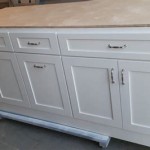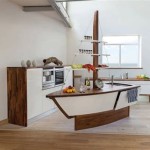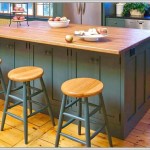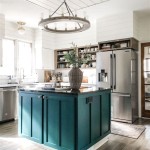Kitchen Island Stool Ideas: A Comprehensive Guide
Kitchen islands have become a central feature in modern homes, offering both workspace and a gathering point for family and friends. A key element of any well-designed kitchen island is the seating, typically in the form of stools. Selecting the right stools can significantly enhance both the aesthetic appeal and functionality of the kitchen. This article explores a variety of kitchen island stool ideas, considering factors such as style, height, material, and comfort to aid in making informed choices.
Understanding Counter and Island Height
Before exploring specific stool styles, it is essential to understand the importance of selecting the correct stool height. The standard countertop height is approximately 36 inches. For counters of this height, counter-height stools, which typically measure 24 to 26 inches from floor to seat, are the most suitable option. When an island incorporates a raised bar area, the height often reaches 40 to 42 inches. In these cases, bar-height stools, measuring 28 to 30 inches from floor to seat, are required to ensure comfortable seating.
Measuring the height of the countertop or raised bar is the first step in selecting the right stools. A general rule of thumb is to allow approximately 10 to 12 inches between the top of the seat and the underside of the counter. This spacing provides adequate legroom and prevents discomfort when sitting for extended periods. Purchasing adjustable-height stools can offer flexibility, particularly in situations where the counter height is slightly non-standard or where different users prefer different seating heights. It's highly recommended to measure and double-check measurements before making a purchase to avoid a disappointing fit.
Exploring Diverse Stool Styles
The style of the kitchen island stool should complement the overall design aesthetic of the kitchen. A wide range of styles are available, from classic and traditional to modern and industrial. Choosing a style that aligns with the existing cabinetry, countertops, and flooring will create a cohesive and visually appealing space. Some of the most popular styles are discussed below.
Traditional Stools
Traditional kitchen island stools often feature ornate detailing, such as turned legs, carved backs, and nailhead trim. These stools are frequently constructed from wood, often with a rich stain or painted finish. Upholstery options include leather, fabric, and patterned textiles. Traditional stools are well-suited for kitchens with a classic or country-style design. The weight and solid construction materials gives them a sense of stability and they can withstand long-term use.
Modern Stools
Modern kitchen island stools typically exhibit clean lines, minimalist designs, and a focus on functionality. Materials such as metal, plastic, and molded plywood are commonly used. Modern stools often incorporate features like adjustable height, swivel mechanisms, and ergonomic seating. These stools are an excellent choice for contemporary kitchens with a sleek and uncluttered aesthetic. Chrome finishes are common as are bold, solid color choices that help integrate with the kitchen's overall design.
Industrial Stools
Industrial kitchen island stools are characterized by their rugged, utilitarian appearance. They often feature metal frames, exposed hardware, and reclaimed wood seats. Industrial stools are a popular choice for kitchens with an industrial-chic or urban-inspired design. The materials are usually durable and designed to look better through years of use. Distressed finishes and visible welding marks are often a deliberately design element.
Transitional Stools
Transitional kitchen island stools bridge the gap between traditional and modern styles. They often combine classic elements with contemporary materials and finishes. These stools are versatile and can be incorporated into a variety of kitchen designs. A transitional stool might use a classic wooden leg design with a sleek, modern upholstered top. The versatility makes them a popular choice.
Material Considerations: Durability and Aesthetics
The choice of material for kitchen island stools impacts both their durability and aesthetic appeal. Different materials offer varying levels of resistance to wear and tear, ease of maintenance, and visual impact. Consider the lifestyle and usage patterns of the kitchen when selecting stool materials.
Wood
Wood is a classic and versatile material for kitchen island stools. It offers a warm and inviting look and can be stained or painted to match any kitchen décor. Wood stools are available in a variety of styles, from traditional to modern. Hardwoods such as oak, maple, and cherry are durable and resistant to wear. Softer woods like pine are less expensive but also less durable. Wood stools require regular cleaning and maintenance to prevent staining and damage from moisture.
Metal
Metal stools are known for their durability and modern aesthetic. Steel and iron are common choices, offering strength and stability. Metal stools can be powder-coated in a variety of colors to match the kitchen décor. They are easy to clean and maintain, making them a practical choice for busy kitchens. However, metal stools can be uncomfortable if not properly padded. Metal tends to be louder than other materials when moved around.
Plastic
Plastic stools are lightweight, affordable, and easy to clean. They are available in a wide range of colors and styles, making them a versatile option for modern kitchens. Plastic stools are resistant to moisture and stains, making them a practical choice for families with young children. However, plastic stools may not be as durable as wood or metal stools and may not be suitable for heavy use.
Upholstery
Upholstered stools add comfort and style to the kitchen. Leather, fabric, and vinyl are common upholstery options. Leather is durable and luxurious but can be expensive and require special care. Fabric is available in a wide range of colors and patterns but can be susceptible to stains and wear. Vinyl is a durable and easy-to-clean option that is ideal for families with young children. When selecting upholstery, consider the overall aesthetic of the kitchen and the level of maintenance required.
Comfort and Functionality: Key Features to Consider
Beyond style and material, comfort and functionality are essential considerations when selecting kitchen island stools. Features such as backrests, armrests, footrests, and swivel mechanisms can significantly enhance the seating experience. Consider the intended use of the stools and the needs of the users when evaluating these features.
Backrests
Stools with backrests provide added support and comfort, particularly for extended periods of sitting. Backrests can range from low-profile designs to full-height backs. The choice of backrest style depends on personal preference and the overall aesthetic of the kitchen. When choosing a backrest, consider both the height and shape of the backrest to ensure that it provides adequate support and comfort.
Armrests
Armrests provide added support and comfort for the arms and shoulders. They are particularly beneficial for individuals who spend a significant amount of time sitting at the kitchen island. Armrests can be fixed or adjustable, depending on the design of the stool. When choosing armrests, consider the height and width of the armrests to ensure that they are comfortable and ergonomic.
Footrests
Footrests provide a place to rest the feet and prevent dangling legs, which can cause discomfort and fatigue. Footrests are particularly important for taller stools, where the feet may not reach the floor. Footrests can be made of metal, wood, or plastic and can be fixed or adjustable. When choosing a footrest, consider the height and position of the footrest to ensure that it is comfortable and accessible.
Swivel Mechanisms
Swivel mechanisms allow the stool to rotate, providing added flexibility and convenience. Swivel stools are particularly useful for kitchens with limited space, as they allow users to easily turn and access different areas of the kitchen. Swivel mechanisms can be either 360-degree or limited-degree rotation. When choosing a swivel stool, consider the smoothness and stability of the swivel mechanism.
Practical Considerations: Space and Quantity
Before purchasing kitchen island stools, it is essential to consider the available space and the number of stools needed. Crowding the island with too many stools can make the kitchen feel cramped and uncomfortable. Conversely, not having enough stools can limit the functionality of the island as a gathering space.
A good rule of thumb is to allow approximately 24 to 30 inches of space per stool. This spacing provides adequate elbow room and prevents users from feeling cramped. Measure the length of the island and divide by 24 or 30 to determine the maximum number of stools that can comfortably fit. Consider the width of the stools as well, as wider stools may require more space.
Consider the frequency of use when determining the number of stools needed. If the island is primarily used for casual meals and snacks, fewer stools may be necessary. If the island is used as a gathering space for family and friends, more stools may be required. It is always better to err on the side of having too few stools than too many. Extra chairs from nearby tables can often fill in, as needed, while too many stools can create unwanted clutter.

A Guide To Barstools And Counter Stools Ideas Advice Lamps Plus

Beautiful Kitchen Counter Stool Ideas And Trends For 2024 Jane At Home

Kitchen Island Bar Stools Pictures Ideas Tips From

Stylish Kitchen Ideas Designer Favorites For 2024 Jane At Home Classic Design Counter Stools Inspiration

Kitchen Island Stools And Pendants That Pair Up Perfectly

For The Perfect Kitchen Island Stools With Backs

Beautiful Kitchen Counter Stool Ideas And Trends For 2024 Jane At Home

60 Great Bar Stool Ideas How To Pick The Perfect Design

25 Trendy New Bar Stool Ideas For Your Dream Kitchen Top Colors And Styles Decoist

Kitchen Island Bar Stools Pictures Ideas Tips From
Related Posts








